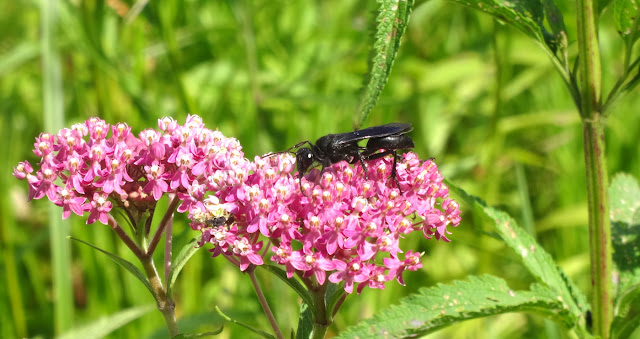The widow skimmer Libellula luctuosa), part of the group 'king skimmer' dragonflies. It has large bulky body (compared to other species odonata) with large heads. This is a juvenile, with yellow with brown stripes.; when adult it will have a steely blue body. Wings are transparent, but marked with prominent black basal bands. Widow Skimmers are found commonly in muddy substrates, or still bodies of waters such as ponds. They prey on other smaller insects like mosquitoes.
6/24/2023
9/12/2021
bee on asters
The asters are abuzz with pollinators. While standing among the wildflowers, I hear the buzzing as loud and pleasant. There are many Panicled Aster Symphyotrichum lanceolatum plants in the riparian area around the pond. The nectar and pollen of the flowerheads attract many kinds of insects, including honeybees, bumblebees, wasps, flies, butterflies, skippers, and beetles. I have not seen any Wild Turkey here, but they feed on the seeds and foliage of aster plants. Maybe some day . . .
8/06/2021
bugs by the pond

7/23/2021
mountain mint
7/03/2021
6/24/2021
galls on goldenrod
6/22/2021
widow skimmer
This dragonfly male 'Widow Skimmer' Libellula luctuosa shows off his handsome transparent wings with black and white structural coloration -- the production of color by microscopically structured surfaces fine enough to interfere with visible light.
The grass seedhead on the left is close to the camera and in front of the wing. But the rush stem behind the wing is showing clearly through the transparent wing while the skimmer rests, clasping that stem.
He is probably looking for prey -- other insects such as mosquitoes. To catch prey he will use his legs, and bring prey into his mouth with fangs.
6/14/2021
5/16/2021
bee swarm
By Sunday morning they had all gone from the tree branch, no trace left behind of their weekend stay.
10/18/2020
boneset in autumn
Boneset Eupatorium perfoliatum has a stout hairy stem, and the plant's leaves occur along it opposite to one another. In autumn, the flowers go to seed, and leaves turn a rich red-brown color.
The leaves are described as 'perfoliate' because each joins the opposite leaf around the stem so it appears the stem grows through one large leaf. All parts of this plant are toxic and bitter. Birds rarely eat the seeds, but are attracted to the flowers for the many insects there.
9/15/2020
9/09/2020
grasshopper on coneflower
On the blooming coneflowers, a Two-striped Grasshopper Melanoplus bivittatus rests in the sunshine. This grasshopper usually lives in sunny, moist, lush, weedy or meadow areas -- like the wetland around the pond. They eat a wide variety of plants, and sometimes also dead animal matter on the ground. They require unsaturated fatty acids in their diet since these nutrients help keep their wings strong and rigid.
9/03/2020
garden spider
8/30/2020
planthopper
Planthoppers are masters of disguise. A green Acanalonid Planthopper, hiding on a stem, can look like part of the plant -- a seed pod, leaf, bract, or stipule.
This one is only 3/8 inch long. It was perched on a stem at the leaf sheath, probably sucking sap from the grass. Planthoppers, true to their name, can leap many times the length of their bodies. And they are very agile insects that can move easily forwards, backwards, or sideways.
8/28/2020
green frogs on rocks

8/19/2020
black wasp
I was surprised and apprehensive to see this big black wasp on a milkweed flower near the pond. It was alarming because of its size (over one inch) but is not a pest to harm people. This Great Black Wasp Sphex pennsylvanicus, looks iridescent violet-black with smoky transparent wings that have a violet sheen. They visit flowers to feed on nectar and pollen; no harm to the plants.
The female Black Wasp digs a burrow in the ground to reproduce her kind. She hunts katydids, paralyzes them, and places several in the burrow. She then lays eggs in the burrow. They hatch into larvae. They have a ready meal, quietly growing into adult Black Wasps.
8/11/2020
ladybug on Mountain Mint
8/02/2020
12 spotted skimmer
7/30/2020
7/25/2020
pennant

Walking along the shore near the pond on an overcast hot day, I noticed a dragonfly perched on a stem of Horsetail.
This is a Halloween Pennant Celithemis eponina dragonfly. They usually perch horizontally like this, waving in the breeze pennant-style, at the top of vegetation.
At 1-1/2 inches long, this dragonfly would be a juicy meal for a predator.





















